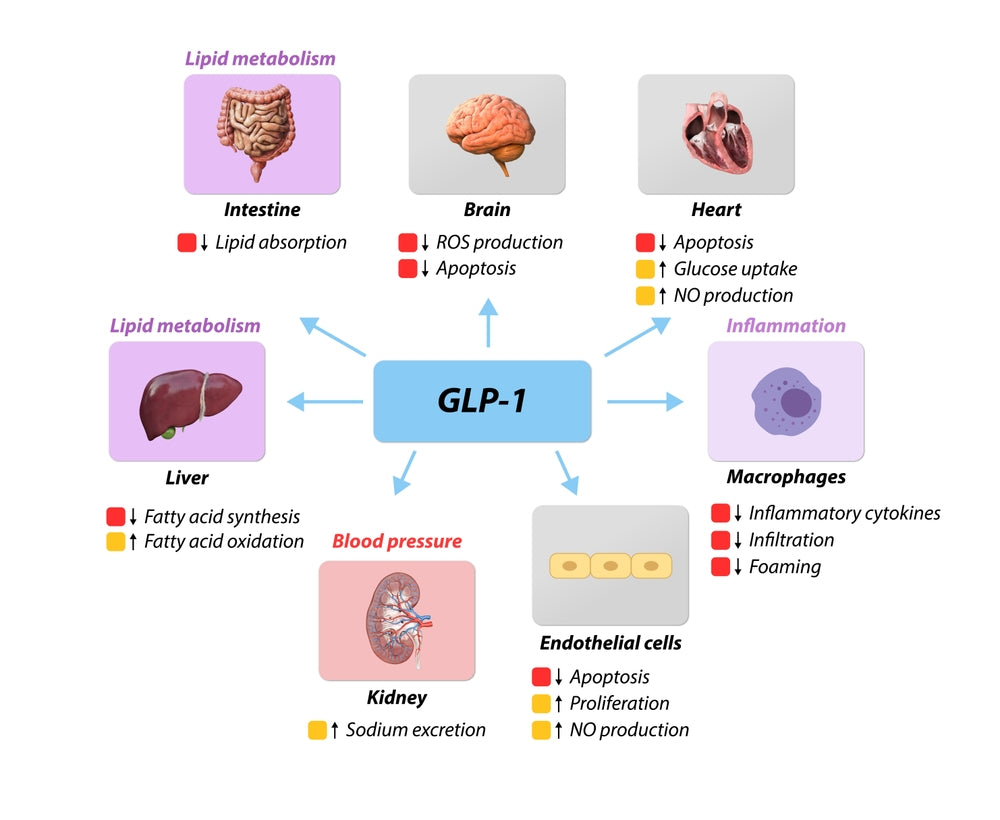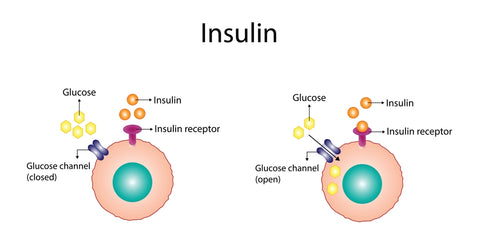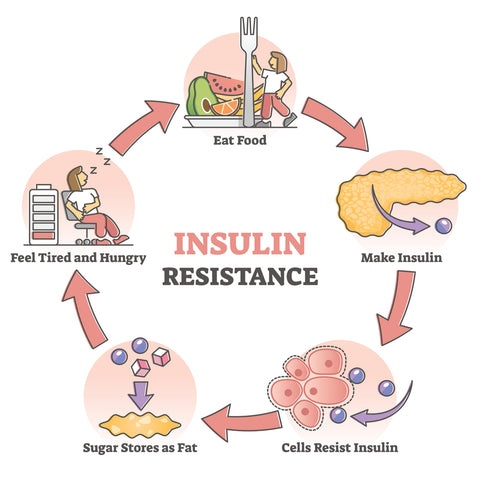Your cart is empty
Free shipping on all US orders


Free shipping on all orders

Have you ever heard of a hormone like peptide that goes by the name GLP-1? Most people would have never heard of it just a short year or two ago. However, that has changed- almost overnight, thanks to its viral explosion, particularly on social medium like Instagram or Tiktok.
Just in case it’s not ringing a bell, we’ve got one word for you- Ozempic.
However, there is much more to know about GLP-1 than its association with Ozempic, as it has existed in our bodies forever, and can be harnessed in ways that do not require a doctor’s prescription.
Ready to learn more? Then let’s get started.
GLP-1, otherwise known as Glucagon-like peptide-1, is a hormone involved in the regulation of blood sugar levels in our body. It plays a pivotal role in ensuring that the amount of glucose, or sugar, in the bloodstream is kept within a healthy range.
This hormone is naturally produced in the intestines after we eat, acting as a signal that helps manage blood sugar levels by affecting the pancreas and other bodily systems.
As briefly mentioned, one of the key functions of GLP-1 is its role in regulating blood sugar levels. When we consume food, GLP-1 works by stimulating the pancreas to release insulin, which helps cells absorb glucose from the blood for energy.
Consequently, this reduces the amount of glucose in the bloodstream, ensuring that it remains in a healthy range. This is particularly important for people with diabetes, who have trouble regulating their blood sugar levels.

In addition to its role in blood sugar regulation, GLP-1 also has significant effects on appetite and weight management. It slows down the movement of food through the stomach, which contributes to a feeling of fullness after eating. This can help reduce overall food intake and, over time, can lead to weight loss. For individuals struggling with obesity or weight-related health issues, this aspect of GLP-1 function is particularly beneficial.
GLP-1 also enhances insulin secretion and sensitivity. This means that not only does it help to increase the amount of insulin released in response to food, but it also makes the body more responsive to insulin. This dual action is crucial for maintaining stable blood sugar levels and preventing the spikes and crashes that can occur in conditions like diabetes.
Medications such as Ozempic leverage the beneficial effects of GLP-1. Ozempic, a synthetic agonist of GLP-1, is used to improve blood sugar control in adults with type 2 diabetes and to support weight management.
By mimicking and stimulating the action of natural GLP-1, Ozempic helps regulate blood sugar levels, reducing appetite, and aiding in weight loss, thereby offering a multifaceted approach to managing diabetes and related health issues.
Although briefly mentioned above, this section aims to explore these benefits in detail, allowing you to appreciate the way these benefits occur.
One of the most significant benefits of GLP-1 is its ability to aid in weight loss and management. GLP-1 works by slowing down the emptying of the stomach, which makes you feel full for a longer time after eating. This can lead to a decrease in overall food intake and, consequently, weight loss.
In addition to this, GLP-1 can reduce appetite by acting on the brain's appetite centers directly. Studies have shown that people who use GLP-1 receptor agonists, which are medications that mimic the action of GLP-1, can achieve significantly more weight loss than they could without assistance. This makes GLP-1 supplementation an extremely promising and valuable tool for managing obesity and its related health issues.
GLP-1 also has beneficial effects in managing type 2 diabetes. By enhancing the release of insulin in response to meals, GLP-1 helps to maintain healthy blood sugar levels. Additionally, it suppresses the release of glucagon, the hormone that raises blood sugar, thereby mitigating blood sugar spikes after meals.

Through these mechanisms, GLP-1 can improve blood sugar control and even reduce the risk of developing type 2 diabetes in people with prediabetes or those at high risk for the disease.
The cardiovascular benefits of GLP-1 are another area of interest. Research indicates that GLP-1 can improve heart health by lowering blood pressure, improving cholesterol levels, and reducing inflammation, which are all contributing risk factors for heart disease.
GLP-1 receptor agonists have also been shown to reduce the risk of major cardiovascular events, such as heart attack and stroke, especially in people with type 2 diabetes. These benefits highlight the potential of GLP-1 in contributing to a healthier heart.
Newer emerging research suggests that GLP-1 might also have benefits for mental health and cognitive function. It is believed that GLP-1 can have protective effects on the brain, potentially improving mood and reducing the risk of developing neurodegenerative diseases like Alzheimer's.
Although this area of research is still in its early stages, the possibility that GLP-1 can contribute to better mental health and cognitive function offers hope for new treatments for mental health conditions and cognitive decline.
Boosting GLP-1 levels naturally can be a strategic approach to enhancing overall health, especially for individuals managing conditions like diabetes. Let’s take a look at what natuiral interventions you can make to help elevate levels of GLP-1.
Dietary fiber is not just beneficial for digestion, but also plays a significant role in boosting GLP-1 levels. Foods high in fiber, such as legumes, whole grains, nuts, seeds, and vegetables, slow down the digestion process.

This slowing allows for a more gradual absorption of nutrients, which in turn, stimulates the release of GLP-1. Incorporating a variety of high-fiber foods into your diet can therefore be an effective strategy for supporting and enhancing GLP-1 production.
Proteins, particularly those found in lean meats, fish, eggs, and plant-based sources like tofu and legumes, can also stimulate GLP-1 release. The mechanism behind this lies in the body's response to protein ingestion, which prompts an increase in nutrient-derived signals that trigger GLP-1 secretion. Including a healthy balance of protein in meals can aid in maintaining stable GLP-1 levels throughout the day.
Inflammation is known to impair the body's ability to produce GLP-1. Thus, incorporating anti-inflammatory foods into your diet can support GLP-1 production. Foods rich in omega-3 fatty acids, such as salmon, chia seeds, and walnuts, alongside fruits and vegetables abundant in antioxidants, can help reduce inflammation and promote a conducive environment for GLP-1 secretion.
If you worry that you’re unable to meet daily requirements of fruits and veggies, supplementing with Field Of Greens superfood powder can help get you there.
A healthy gut is crucial for optimal GLP-1 production. The gut microbiome, which comprises the trillions of bacteria living in our digestive system, plays a significant role in this process. A balanced diet rich in prebiotics (found in foods like garlic, onions, and asparagus) and probiotics (found in yogurt, kefir, and fermented foods) can support a healthy gut microbiome, enhancing GLP-1 production. Ensuring gut health through diet not only supports GLP-1 levels but also contributes to your overall well-being.
How often do you exercise? For many people, the answer is a far cry from enough. Physical activity is a powerful tool for boosting GLP-1 levels. Exercise enhances the body's sensitivity to GLP-1, making it more effective at regulating blood sugar levels.
Regular, moderate intensity exercise, such as brisk walking, cycling, or swimming, can significantly contribute to maintaining healthy GLP-1 levels.
Add in a few resistance training sessions per week, and you’ve got a good thing going.
Did you even need another reason to get more sleep? Sleep plays a critical role in the regulation of numerous hormones, including GLP-1. Lack of sleep or poor-quality sleep can disrupt the body's normal hormone production cycles, including GLP-1 secretion. Ensuring 7 to 8 hours of quality sleep per night can help support healthy GLP-1 levels.
If the shut-eye eludes you, a natural non-habit forming sleep aide like Dreamzzz can get your sleep cycle back on track.
Chronic stress can negatively affect so much more than GLP-1 production. When the body is under stress, it releases cortisol, a hormone that can inhibit GLP-1 secretion. Managing excessive stress through techniques such as mindfulness, meditation, or even regular physical activity can help mitigate this effect and support healthy GLP-1 levels.
In recent years, several supplements have gained attention for their potential to boost GLP-1 production. Many have been around for a while, are widely accepted and generally recognized as safe. These include:
Prebiotic supplements are a fascinating area of study, especially when we look into their role in stimulating GLP-1. It has a significant job: it slows down the emptying of our stomach, making us feel full for longer, and it also helps in lowering blood sugar levels by enhancing insulin secretion.
So, where do prebiotic supplements fit into this picture? Prebiotics are essentially food ingredients that the human body cannot digest. They serve as food for the 'good' bacteria in our gut, helping them grow and flourish. These beneficial bacteria, in turn, have a positive impact on our overall health, including the stimulation of GLP-1 secretion.
How exactly do these supplements stimulate GLP-1? The process is quite intriguing. When prebiotics feed the beneficial bacteria in our gut, these bacteria produce short-chain fatty acids as a byproduct of their digestion.
These fatty acids then act on the cells lining our intestines, which leads to an increase in the production of GLP-1. This increase in GLP-1 not only helps with the regulation of appetite and blood sugar but also has broader implications for managing conditions like diabetes and obesity.
Omega-3 fatty acids are essential fats found in foods like fish and flaxseeds, playing a crucial role in our health. Omega-3s are known for their anti-inflammatory properties and their contribution to heart and brain health. But more interestingly, research has shown that they can stimulate the production of GLP-1.

The interaction between omega-3 fatty acids and GLP-1 stimulation involves several biological pathways. Omega-3s can enhance the sensitivity of GLP-1 receptors, the special proteins on cell surfaces that recognize and respond to GLP-1.
This means the body can react more effectively to the hormone, improving insulin sensitivity and promoting a feeling of fullness. Additionally, omega-3s have anti-inflammatory properties, which may help protect GLP-1-producing cells, ensuring they function properly.
Another aspect is how omega-3 fatty acids influence the composition of gut bacteria. A healthy gut microbiome has been linked to increased GLP-1 production. Omega-3s can alter the gut flora in a way that boosts the number of beneficial bacteria, which in turn, can stimulate more GLP-1 production.
Ginseng, a popular herb used in traditional medicine, has been shown to have positive effects on GLP-1 levels. There are several types of ginseng, but studies focusing on its impact on GLP-1 have primarily examined American and Korean varieties. Ginseng is thought to increase GLP-1 production by enhancing the L-cells' activity in the gut, much like omega-3 fatty acids. Additionally, ginseng may improve glucose tolerance, making it a potentially valuable supplement for those looking to manage their blood sugar levels and weight.
Psyllium is a form of fiber derived from the husks of the Plantago ovata plant's seeds. It's well-known for its ability to support digestive health, but it also has a role in stimulating GLP-1 production. By slowing down digestion, psyllium can help regulate blood sugar levels and contribute to a feeling of fullness, which in turn, can aid in weight management.
Recommended Dose: The typical daily dose of psyllium is between 5-10 grams, taken with at least one glass of water to facilitate its absorption and efficacy.
Curcumin is the active compound found in turmeric, a spice that not only adds color and flavor to dishes but also offers significant health benefits. Among these, curcumin has been shown to enhance GLP-1 levels, contributing to improved insulin sensitivity and reduced inflammation.

Recommended Dose: For general health benefits, including GLP-1 stimulation, doses of curcumin typically range from 500-2,000 mg per day. However, it's important to note that curcumin is best absorbed when taken with black pepper (piperine) or fats.
Berberine is a compound found in several plants, including barberry, Oregon grape, and goldenseal. It's known for its ability to improve various health markers, especially for those with type 2 diabetes.
Berberine works by activating an enzyme called AMP-activated protein kinase (AMPK), which in turn stimulates the release of GLP-1. Berberine is one of the most common stand-alone supplements used today for assisting with blood glucose management.
Recommended Dose: The common dosage for berberine is 300-500 mg taken three times daily, before meals. This spacing helps maximize its blood sugar-regulating effects.
Fenugreek, a common ingredient in cuisine and traditional medicine, has garnered attention for its potential benefits in managing blood sugar levels and enhancing metabolic health.

Some of the active compounds in fenugreek, such as the saponins, are believed to be responsible for its effects on GLP-1 secretion. The fiber in fenugreek can delay carbohydrate digestion and absorption, leading to a more gradual increase in blood glucose levels.
This slower absorption triggers the intestines to release more GLP-1. Additionally, fenugreek's saponins may directly stimulate L cells in the intestines, which are responsible for GLP-1 secretion, further enhancing its release.
By stimulating GLP-1 secretion, fenugreek supplementation can help improve insulin sensitivity, reduce hyperglycemia, and possibly aid in weight management. However, the precise molecular mechanisms underlying these effects are still being explored, and more research is needed to fully understand the potential of fenugreek in metabolic health management.
To achieve optimal benefits from these supplements, it's crucial to incorporate them into your daily routine thoughtfully:
The discovery and utilization of GLP-1 agonists have marked a significant advancement, particularly in the management of diabetes and obesity. These treatments should be reserved for people who exhibit poor glycemic control even after rounds of more common treatments, or with obesity classified as morbid.
Here’s a bit about these agonists.
GLP-1 receptor agonists are a class of medications that mimic the action of the naturally occurring GLP-1 hormone. By activating GLP-1 receptors, these drugs enhance the body's ability to lower blood sugar levels, primarily after meals, thereby offering a targeted approach to managing diabetes.
Some well-known brand names include Liraglutide (Victoza), Exenatide (Byetta), and Semaglutide (Ozempic). These medications are administered through injections and, more recently, in pill form for certain drugs, making them more accessible to a broader range of patients.
One of the most remarkable aspects of GLP-1 receptor agonists is their dual efficacy in both diabetes management and weight loss. In diabetes, these medications work by increasing insulin release in response to high blood sugar levels, while simultaneously slowing down gastric emptying, which helps in moderating blood sugar spikes after meals.
They also suppress appetite, which can lead to reduced calorie intake and, consequently, weight loss. This dual action makes GLP-1 receptor agonists particularly beneficial for individuals with type 2 diabetes who are also overweight or obese, addressing two significant health concerns with a single treatment approach.
While GLP-1 based treatments offer promising benefits, they come with their set of considerations and potential side effects. One of the more common side effects is gastroparesis, a condition characterized by delayed stomach emptying, which can lead to symptoms like nausea, vomiting, abdominal discomfort, and worse.
Other potential side effects include hypoglycemia (especially when used with other diabetes medications that lower blood sugar), pancreatitis, kidney problems, and possible thyroid tumors. It's important for patients and healthcare providers to engage in a thorough discussion about the benefits and risks of these medications, taking into account individual health profiles and treatment goals.
The effectiveness and safety of GLP-1 receptor agonists can vary immensely based on other individual factors, including existing health conditions and medications being taken. Therefore, a personalized approach to treatment, closely monitored by a healthcare provider, is essential for optimizing outcomes while minimizing adverse effects.
Side-effects aside, you still need to be aware of the “best practices” when taking these types of medications/ supplements. These may include:
GLP-1 boosting supplements are primarily recommended for individuals who are managing type 2 diabetes and obesity. These supplements mimic the action of the natural hormone GLP-1, which is involved in regulating blood sugar levels and decreasing appetite. Consequently, they can be particularly beneficial for those looking to improve their glycemic control and aid in weight loss efforts.
Persons with type 2 diabetes may find GLP-1 supplements helpful as part of their treatment plan to lower their blood sugar levels, especially if traditional medications are not fully effective or cause undesirable side effects.
Additionally, individuals struggling with obesity may consider taking GLP-1 supplements under medical guidance to help reduce food intake and promote weight loss, potentially lowering the risk of developing obesity-related complications. It's important for anyone considering GLP-1 supplements to consult with a healthcare provider to ensure they are appropriate for their specific health situation and to discuss potential benefits and risks.
When it comes to supplement forms of GLP-1 boosters, they are almost solely administered by the oral route (mouth). The prescription forms (Ozempic and others) are mainly available in subcutaneous injectable forms, although developments have led to the formulation of oral versions, in some cases.
Research is ongoing, but current evidence suggests that GLP-1 supplements are generally safe when consumed in a sensible manner. It goes without saying that care must still be taken with regard to following dosage guidelines and ensuring safety.
While many people with type 2 diabetes may benefit from GLP-1 supplements, they are not suitable for everyone, including those with type 1 diabetes. If you’re unsure if they are the right fit for you, consult your pharmacist or physician before use.
Yes, they can interact with other medications, including insulin. That’s why it's crucial to inform your healthcare provider about all medications and supplements you're taking to avoid adverse interactions.
The effects on blood sugar levels can be seen soon after starting the supplements, but changes in appetite and weight may take a few weeks to become noticeable.
Remember- this isn’t about speed; you need to stick around for the long haul.
No, GLP-1 supplements are not a cure. They are a management option that can help alleviate symptoms and improve quality of life but need to be part of a broader health management plan. As with any supplement, they are just one part of the equation that also includes dietary and lifestyle changes.
Many things have been said about GLP-1 boosters; some bad, but many more that are good. Are they beneficial? Absolutely. In fact, many people swear by them. However, you still need to be smart about using them- don’t think that they are a miracle cure that does all the work without you doing the work.